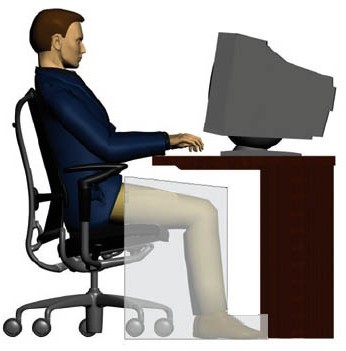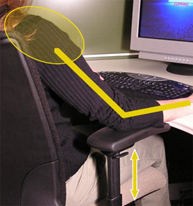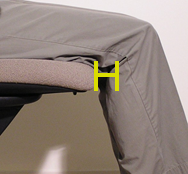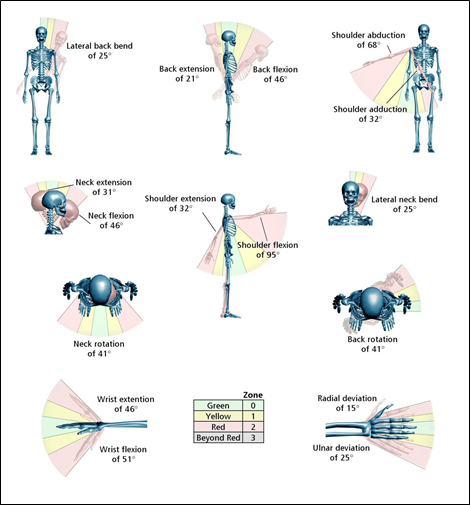No one sits still
In the real world there is no such thing as the office worker depicted to the left—head up, eyes focused on the upper third of the monitor, spine erect, feet supported, elbows angled at 90- degrees, wrists straight with hands poised just above the keyboard. At least this is seldom seen. Yet text- books and ergonomic guidelines habitually use such illustrations to represent the “ideal” seated position. Is it? (Figure 1)
Scientific (and casual) observation of what office workers do at their desks reveals a different picture. People are always moving. They change positions constantly: they recline while taking a phone call, bend forward to resume work, turn around to look at someone, reach up for a report, slide their chairs forward, backward, and sideways to access items within their work areas; and so forth. The variations are endless.
This is good. Movement stimulates circulation, which supplies nutrients to tissues and removes wastes, resulting in greater alertness and less fatigue throughout the day. Current ergonomic thinking calls for acknowledgement of this natural behavior, and for solutions that work with it, rather than strategies aimed at modifying or overriding it. Freedom of movement is the goal.
Dynamic Seated Work: Three Essentials
Encouraging safe, comfortable movement for the seated worker requires attention to three essentials: stability, clearance, and position.
Stability
Stability is the basis of controlled, comfortable, and efficient movement from a sitting position. It is achieved by supporting feet, buttocks, back, and forearms.
-
- Supporting the Buttocks. In seatedSupporting the Feet. Feet should rest squarely and firmly on the floor or on a footrest, with knees bent somewhere between the angles of 85° and 110°. This provides “ground reference,” i.e., connection to the ground. If the chair’s seat is too high and the user’s feet don’t reach the floor, a primary source of balance and support for the upper body is missing. In contrast, a seat too low compromises ground reference. Though allowing contact with the floor, it elevates the knees, weakening the optimal structural relationship between floor, feet, legs, and the rest of the body. Thus, the first step toward stability is adjusting seat height to an effective level (Figure 2).position, the ischial tuberocities, or “sit-bones” of the pelvis, along with the surrounding musculature of the buttocks and upper legs, bear the weight of the upper body. This is the body’s principal anchor, its main source of stability. For optimum support and comfort, chair seat pans are sized and shaped to distribute this weight over as much area as possible, with padding that will compress and conform to the user’s body.
- Supporting the Back. A normal, healthy spinal column has a series of curves that support the weight and movements of the upper body. For most people this natural S- shape is the back’s “default position” when standing. However, when sitting the inward lumbar curve of the lower back (sometimes referred to as the “lumbar lordosis”) tends to flatten, causing the shoulders to droop forward and the pelvis to rotate backward so that the tail- bone curves down and under. The slumped position introduces stress in the thoracic and lumbar regions of the back, in the pelvis, and in the shoulders and neck (Figure 3). To counteract this and allow the spine to maintain its naturally supportive curvature, modern office chairs all offer some level of lumbar support. These usually come in the form of
passive supports (backrests that passively adjust to maintain the curve in the small of the back), and active supports (manually adjust- able backrests that “push” against the lower back). Innovative designs are now providing dynamic, adaptive lumbar technology that provides an appropriate level of support—from sitting upright to re- clined—as the worker moves and changes position spontaneously throughout the day.
- Supporting the Forearms. Lifting and extending the arms repeatedly and holding them in extension in- troduce stress to the rotator cuffs and bursae of the shoulders. Thus, prolonged use of a keyboard and mouse can lead to repetitive strain injuries (RSI) in shoulders if arm supports are not present or used. Likewise, carpal tunnel syndrome and tendonitis may result from mousing and keyboarding with wrists out of a comfortable neutral position. Both problems can be avoided by supporting the forearms. Properly adjusted, these supports take the load off shoulders and neck, and eliminate awkward wrist angles, allowing easy efficient use of arms and fingers (Figure 4).
Clearance
Freedom of movement requires elimi- nation of barriers. Barriers in the seated worker’s immediate surround- ings mean inefficient movement, and sometimes strain, to avoid or accom- modate them. Not all such maneuvers are harmful, but some can throw a stable posture out of balance, putting stress on the musculoskeletal systemand introducing the risk of injury. Two common clearance problems relate to seat depth and worksurface height.
- Seat Depth. Seat depth, or the front- to-back length of the seat pan, poses two potential problems if not adjusted: First, the lip of the seat may contact the popliteal fossa, the area behind the knee through which the primary blood vessels and nerve pathways lead to the lower legs and feet. Compression here may lead to pain, numbness, or swelling. Sec- ond, if the user moves forward to allow clearance, the lower back will also move forward, taking away the backrest’s support of the lumbar curve. This will lead to the droop- ing, round-shouldered posture de- scribed above. Correct seat depth adjustment will allow firm contact between the chair’s lumbar support and the lower back, leaving 2-3 fin- ger widths between the front edge of the seat pan and the back of the knees (Figure 5).
- Worksurface Height. Any worksur- face too high in relation to the fore- arms and hands creates a clearance barrier. (A visual indicator of the problem is elbows below and hands above the level of the ) In such a case, where wrists cross the edge of the surface, direct con- tact and wrist flexion compress ten- dons. Repetitive stress of this kind usually leads to carpal tunnel in- flammation. The ideal position is elbows and forearms even with or slightly above the height of the worksurface (Figure 4). Proper clearance can be achieved via one or more adjustments: a. chair
height; b. armrest height; c. work- surface height. (Since height- adjustable workstations are still un- common in most offices, usually it is chair and armrest heights that are adjusted for an effective relation- ship to the work surface.)
Position
Movement is good. But how far should you go when bending, turning, or reaching? The mechanics of the musculoskeletal system allow a wide range of positions. These may be cate- gorized according to stress on the sys- tem. Practically, stress levels can be divided into four zones, zero through three. The neutral zone (0) is the range of safe and comfortable movement workers should aim for. (In the illus- trations, the neutral zone is color- coded green.) Zone 1 (yellow), while introducing more stress, is generally in the acceptable range. Zone 2 (red) is a danger zone, and Zone 3 (gray) sug- gests high risk of injury for most peo- ple if performing repetitive, heavy, or frequent tasks. Today’s ergonomic workstations and chairs should offer stability and support for most posi- tions within Zones 0 and 1. But it is up to the worker to know the limits of safety and to keep these in mind. No workstation, no matter how ergonomi- cally advanced, can help a worker who bends, twists, or stretches too far or too often (Figure 6).
Real and Ideal
Returning to the drawing of the seated worker on the front page of this paper, and considering the principles of Stability, Clearance, and Position, it should be clear that this actually is anideal seated posture for desk and key- board work. In the drawing, feet, back, buttocks, and forearms are well supported, providing stability. Clear- ance is excellent: there are no barriers to movement or circulation. And the head, neck, forearms, wrists, hands— in fact, the entire body—is in the green zone, the desirable neutral posi- tion. At the same time, this idealized picture does not imply a worker should stay put. (In fact, for pro- longed-focus tasks like data entry, workers are encouraged to get up from the chair occasionally to stretch, bend, and move.) As we have said, workers do not sit still. With modern office furniture, most of their natural, spon- taneous movement is encouraged and
supported. Healthy freedom of move- ment with comfort and safety is to- day’s performance standard. It is sound ergonomics, and good sense.
Ergonomics
Our ergonomics team studies workers: who they are, the way they work, and what they need to be comfortable and healthy. These insights are built into every product we make. Commitment to ergonomics is clearly reflected in advanced chair designs with dynamic adaptive back support, and height- adjustable work surfaces.
Credits
Scott Openshaw, M.S., heads Ergonomics Group. With an academic background in Human Biology and Biomedical Engineering, Scott applies human factors and ergonomics principles to the design of office furniture. Scott has taught Rehabilitation Engineering at the university level and is currently a doctoral candidate in Industrial Engineering at the University of Iowa. He is a member of the Human Factors and Ergonomics Society and the Institute of Industrial Engineers.
Drew Bossen, P.T., is founder of Atlas Ergonomics, an ergonomics consultancy with expertise in multidisciplinary prevention-oriented programs for minimizing occupational injuries in office settings, healthcare facilities, the industrial workplace, and transportation fleets. Drew is a member of the Human Factors and Ergonomics Society and the American Physical Therapy Association, where he serves on the organization’s Occupational Health Executive Committee, among other leadership roles.








